Due to the US Government shutdown, the Smithsonian is temporarily closed. The Global Volcanism Program website will remain available but will not be monitored or updated. Status updates will be available on the Smithsonian homepage.


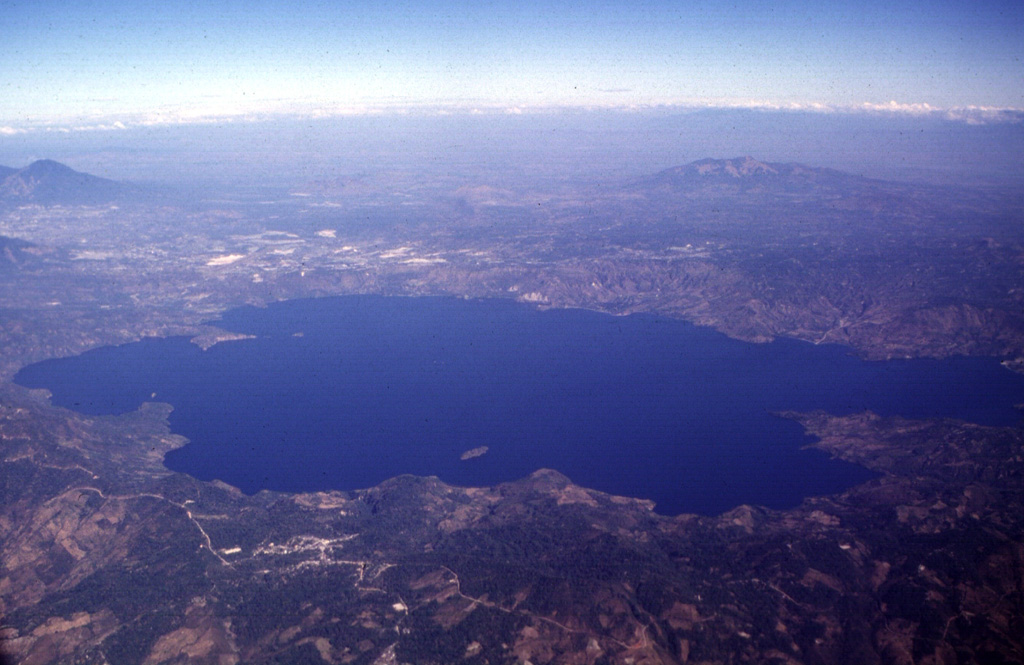
The Global Volcanism Program has no activity reports available for Ilopango.
The Global Volcanism Program has no Weekly Reports available for Ilopango.
The Global Volcanism Program has no Bulletin Reports available for Ilopango.
|
|
||||||||||||||||||||||||||||
There is data available for 2 confirmed eruptive periods.
1879 Dec 31 - 1880 Mar 26 ± 5 days Confirmed Eruption (Explosive / Effusive) VEI: 3
| Episode 1 | Eruption (Explosive / Effusive) | Islas Quemadas, Lake Ilopango | ||||||||||||||||||||||||||||||||||||||||||||||||
|---|---|---|---|---|---|---|---|---|---|---|---|---|---|---|---|---|---|---|---|---|---|---|---|---|---|---|---|---|---|---|---|---|---|---|---|---|---|---|---|---|---|---|---|---|---|---|---|---|---|
| 1879 Dec 31 - 1880 Mar 26 ± 5 days | Evidence from Observations: Reported | ||||||||||||||||||||||||||||||||||||||||||||||||
| Following severe earthquakes 20-31 December 1879, the water level in Lake Ilopango rose over 6-11 January 1880, accompanying growth of the Islas Quemadas lava dome. By 9 January discharge down the Jiboa River was strong enough to flood the valley, destroying the town of Atuscatla and killing many cattle. A huge column of ash and incandescent rocks was observed on 20 January and the dome breached the surface on 23 January; three periods of dome growth accompanied by explosions ensued. The dome reached a height of 50 m above the lake before explosions 5 March destroyed most of the subaerial portion. CAVW considers the onset of seismicity on 31 December 1879 to mark the onset of dome growth and notes that the eruption ended in late March. | |||||||||||||||||||||||||||||||||||||||||||||||||
|
List of 8 Events for Episode 1 at Islas Quemadas, Lake Ilopango
|
|||||||||||||||||||||||||||||||||||||||||||||||||
0450 ± 30 years Confirmed Eruption (Explosive / Effusive) VEI: 6
| Episode 1 | Eruption (Explosive / Effusive) | Tierra Blanca Joven | ||||||||||||||||||||||||||||||||||||||||||||||||||||||||||||||||||||
|---|---|---|---|---|---|---|---|---|---|---|---|---|---|---|---|---|---|---|---|---|---|---|---|---|---|---|---|---|---|---|---|---|---|---|---|---|---|---|---|---|---|---|---|---|---|---|---|---|---|---|---|---|---|---|---|---|---|---|---|---|---|---|---|---|---|---|---|---|---|
| 0450 ± 30 years - Unknown | Evidence from Isotopic: 14C (calibrated) | ||||||||||||||||||||||||||||||||||||||||||||||||||||||||||||||||||||
| The massive Tierra Blanca eruption (14C dated 260 ± 114 CE) destroyed early Mayan cities and resulted in the formation of the Ilopango Caldera (Sheets, 1979). AMS radiocarbon dating combined with careful analysis of previous dates provided a weighted age of 1605 ± 20 yrs BP (Dull et al., 2001). This has a 2-sigma calendar age of 408-536 CE, with the probability distribution weighted toward the early part of this range, between 415 and 476 CE. Dull et al. (2001) noted evidence for sudden evacuation of archaeological sites over broad areas after about 400 CE, and Sheets (2004) estimated 30,000 fatalities within the area swept by pyroclastic flows. The 71 km3 airfall tephra volume (Kutterolf et al., 2008) does not include the unknown volume of pyroclastic flows. | |||||||||||||||||||||||||||||||||||||||||||||||||||||||||||||||||||||
|
List of 12 Events for Episode 1 at Tierra Blanca Joven
|
|||||||||||||||||||||||||||||||||||||||||||||||||||||||||||||||||||||
This compilation of synonyms and subsidiary features may not be comprehensive. Features are organized into four major categories: Cones, Craters, Domes, and Thermal Features. Synonyms of features appear indented below the primary name. In some cases additional feature type, elevation, or location details are provided.
Synonyms |
||||
| Cojutepeque | ||||
Cones |
||||
| Feature Name | Feature Type | Elevation | Latitude | Longitude |
| Pavas, Cerro las | Stratovolcano | 1025 m | 13° 43' 0.00" N | 88° 56' 0.00" W |
Domes |
||||
| Feature Name | Feature Type | Elevation | Latitude | Longitude |
| Buena Vista, Cerro | Dome | 822 m | 13° 43' 0.00" N | 89° 1' 0.00" W |
| Chachacaste, Cerro
Conacaste, Cerro |
Dome | 830 m | 13° 46' 0.00" N | 88° 56' 0.00" W |
| Colorado, Cerro
Chocolate, Cerro |
Dome | 820 m | 13° 45' 0.00" N | 88° 56' 0.00" W |
| Delicias, Cerro las | Dome | 13° 45' 0.00" N | 89° 4' 0.00" W | |
| Espino, Cerrito el | Dome | 13° 46' 0.00" N | 89° 1' 0.00" W | |
| Micos, Cerro de los | Dome | 13° 39' 0.00" N | 89° 2' 0.00" W | |
| Palma Sur, Cerrito la | Dome | 13° 43' 0.00" N | 89° 4' 0.00" W | |
| Patos, Islas de los | Dome | 13° 39' 0.00" N | 89° 2' 0.00" W | |
| Punta Zacatepeque | Dome | 13° 42' 0.00" N | 89° 2' 0.00" W | |
| Quemadas, Islas
Quemados, Cerros |
Dome | 450 m | 13° 40' 18.00" N | 89° 3' 12.00" W |
| Rosario, Cerro del | Dome | 700 m | 13° 46' 0.00" N | 88° 54' 0.00" W |
| San Jacinto, Cerro | Dome | 13° 41' 0.00" N | 89° 10' 0.00" W | |
| San Pedro, Lomas de | Dome | 13° 47' 0.00" N | 89° 0' 0.00" W | |
| Tecoluca, Cerro | Dome | 13° 46' 0.00" N | 89° 1' 0.00" W | |
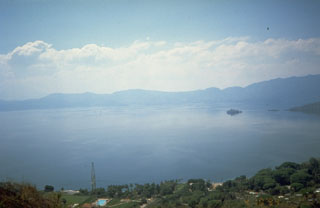 The 8 x 11 km Ilopango caldera, filled by one of El Salvador's largest lakes, has a scalloped 150-500 m high rim. The caldera, seen here from its west rim, is strongly controlled by regional faults of the central Salvador graben. Its latest collapse resulted from the massive 5th century CE Tierra Blanca eruption that produced widespread pyroclastic flows and devastated early Mayan cities. The latest of a series of post-caldera eruptions formed the Islas Quemadas, a group of low islets in the center of the lake, in 1879-1880.
The 8 x 11 km Ilopango caldera, filled by one of El Salvador's largest lakes, has a scalloped 150-500 m high rim. The caldera, seen here from its west rim, is strongly controlled by regional faults of the central Salvador graben. Its latest collapse resulted from the massive 5th century CE Tierra Blanca eruption that produced widespread pyroclastic flows and devastated early Mayan cities. The latest of a series of post-caldera eruptions formed the Islas Quemadas, a group of low islets in the center of the lake, in 1879-1880.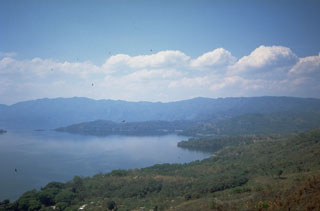 The SW wall of Ilopango caldera rises about 500 m above the surface of the caldera lake. Punta La Peninsula (center) on the western side of the caldera extends a kilometer into the lake. The high wall on the southern side of the lake is a fault scarp in southward-dipping rocks of the Pliocene Balsamo formation. The scenic lake is a popular resort destination from the capital city of San Salvador, and the shores of the lake are dotted with resorts and vacation homes.
The SW wall of Ilopango caldera rises about 500 m above the surface of the caldera lake. Punta La Peninsula (center) on the western side of the caldera extends a kilometer into the lake. The high wall on the southern side of the lake is a fault scarp in southward-dipping rocks of the Pliocene Balsamo formation. The scenic lake is a popular resort destination from the capital city of San Salvador, and the shores of the lake are dotted with resorts and vacation homes. 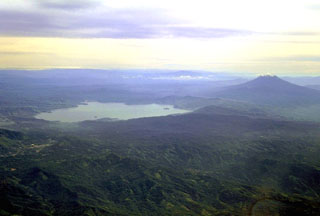 Ilopango caldera is seen in this aerial view from the SW with San Vicente stratovolcano to the right. The latest collapse of the 13 x 17 km caldera occurred after a powerful eruption during 536-550 CE that produced widespread pyroclastic flows and devastated early Mayan cities. The caldera now contains a lake with lava domes forming small islands near the shore and near its center.
Ilopango caldera is seen in this aerial view from the SW with San Vicente stratovolcano to the right. The latest collapse of the 13 x 17 km caldera occurred after a powerful eruption during 536-550 CE that produced widespread pyroclastic flows and devastated early Mayan cities. The caldera now contains a lake with lava domes forming small islands near the shore and near its center.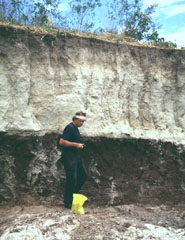 Volcanologist Jim Vallance samples the TB3 (Tierra Blanca 3) deposit, the second oldest of four major deposits associated with the formation of Ilopango caldera. This outcrop is located south of the town of Panchimalco, about 20-30 km SW of the caldera.
Volcanologist Jim Vallance samples the TB3 (Tierra Blanca 3) deposit, the second oldest of four major deposits associated with the formation of Ilopango caldera. This outcrop is located south of the town of Panchimalco, about 20-30 km SW of the caldera. The 13 x 17 km Ilopango caldera is filled by one of El Salvador's largest lakes. The caldera, which has a scalloped 150-500 m high rim, lies immediately east of the capital city of San Salvador (upper left). The latest caldera collapse event occurred during the massive 536-550 CE eruption, which produced widespread pyroclastic flows and devastated early Mayan cities. Post-caldera eruptions formed a series of lava domes within the lake and near its shore.
The 13 x 17 km Ilopango caldera is filled by one of El Salvador's largest lakes. The caldera, which has a scalloped 150-500 m high rim, lies immediately east of the capital city of San Salvador (upper left). The latest caldera collapse event occurred during the massive 536-550 CE eruption, which produced widespread pyroclastic flows and devastated early Mayan cities. Post-caldera eruptions formed a series of lava domes within the lake and near its shore.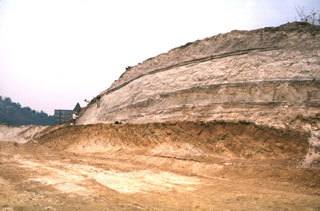 Four major pyroclastic units associated with the incremental formation of Ilopango caldera are exposed in this quarry. The Tierra Blanca (White Soil) unit that was emplaced over much of central and western El Salvador consists of (from bottom to top) the Pleistocene TB4 (the orange-colored unit at the base), TB3, and TB2 units (separated by thin soils), and the Holocene TBJ unit. The latter is called the Tierra Blanca Joven (the young Tierra Blanca) and was erupted about 1,500 years ago. Note the geologist on the left side of the outcrop for scale.
Four major pyroclastic units associated with the incremental formation of Ilopango caldera are exposed in this quarry. The Tierra Blanca (White Soil) unit that was emplaced over much of central and western El Salvador consists of (from bottom to top) the Pleistocene TB4 (the orange-colored unit at the base), TB3, and TB2 units (separated by thin soils), and the Holocene TBJ unit. The latter is called the Tierra Blanca Joven (the young Tierra Blanca) and was erupted about 1,500 years ago. Note the geologist on the left side of the outcrop for scale. 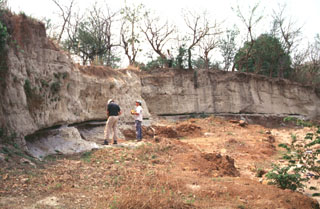 Geologists investigate an outcrop of the Tierra Blanca Joven (TBJ) formation about 10 km SE of Ilopango caldera where it originated. The TBJ was produced during the last of four major explosive eruptions that formed the caldera and deposited pyroclastic flows, ashfall, and pumice across much of central and western El Salvador. The eruption destroyed early Mayan cities and forced their abandonment for decades to centuries. Trade routes were disrupted, and the centers of Mayan civilization shifted from the highland areas of El Salvador to lowland areas to the north and in Guatemala.
Geologists investigate an outcrop of the Tierra Blanca Joven (TBJ) formation about 10 km SE of Ilopango caldera where it originated. The TBJ was produced during the last of four major explosive eruptions that formed the caldera and deposited pyroclastic flows, ashfall, and pumice across much of central and western El Salvador. The eruption destroyed early Mayan cities and forced their abandonment for decades to centuries. Trade routes were disrupted, and the centers of Mayan civilization shifted from the highland areas of El Salvador to lowland areas to the north and in Guatemala.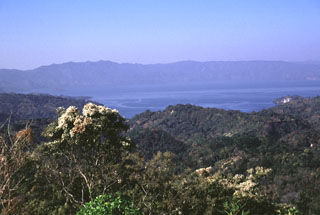 The 13 x 17 km Ilopango caldera is seen here from the NE with the southern caldera wall in the background. It formed during four major Quaternary eruptions, the last of which occurred about 1,500 years ago. The southern caldera wall rises about 500 m above the lake, which had a maximum depth of about 230 m when this photo was taken in 1999.
The 13 x 17 km Ilopango caldera is seen here from the NE with the southern caldera wall in the background. It formed during four major Quaternary eruptions, the last of which occurred about 1,500 years ago. The southern caldera wall rises about 500 m above the lake, which had a maximum depth of about 230 m when this photo was taken in 1999. 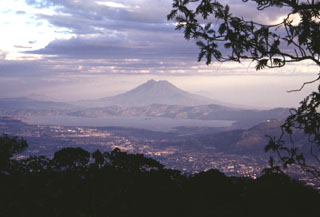 Lake Ilopango occupies the Ilopango caldera immediately east of the capital city of El Salvador, seen in the foreground. This view is from San Salvador volcano with San Vicente volcano in the background. The caldera formed during four major eruptions, the last of which was about 1,500 years ago. This eruption deposited ash and pumice over much of central and western El Salvador.
Lake Ilopango occupies the Ilopango caldera immediately east of the capital city of El Salvador, seen in the foreground. This view is from San Salvador volcano with San Vicente volcano in the background. The caldera formed during four major eruptions, the last of which was about 1,500 years ago. This eruption deposited ash and pumice over much of central and western El Salvador.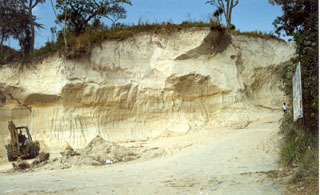 Pyroclastic flow and ashfall deposits from Ilopango caldera, known collectively as Tierra Blanca (White Soil), are found over much of central and western El Salvador. This quarry near the city of Cojutepeque (9 km ENE of the caldera) exposes the Tierra Blanca Joven (TBJ) formation that was produced during the youngest of several Tierra Blanca eruptions about 1,500 years ago. The eruption destroyed early Mayan cities and resulted in their abandonment for decades to centuries.
Pyroclastic flow and ashfall deposits from Ilopango caldera, known collectively as Tierra Blanca (White Soil), are found over much of central and western El Salvador. This quarry near the city of Cojutepeque (9 km ENE of the caldera) exposes the Tierra Blanca Joven (TBJ) formation that was produced during the youngest of several Tierra Blanca eruptions about 1,500 years ago. The eruption destroyed early Mayan cities and resulted in their abandonment for decades to centuries.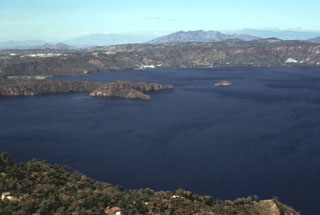 The western side of Lake Ilopango is seen from the southern rim of Ilopango caldera. The broad peak on the right-hand horizon is the Pleistocene Guazapa volcano. The northern wall of Ilopango caldera rises about 400-500 m above the lake. Much of the caldera rim contains thick caldera-forming eruption deposits, and some lava domes are exposed in the caldera wall.
The western side of Lake Ilopango is seen from the southern rim of Ilopango caldera. The broad peak on the right-hand horizon is the Pleistocene Guazapa volcano. The northern wall of Ilopango caldera rises about 400-500 m above the lake. Much of the caldera rim contains thick caldera-forming eruption deposits, and some lava domes are exposed in the caldera wall.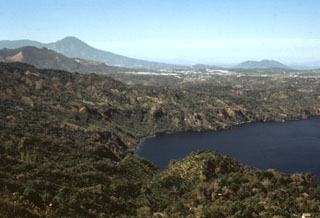 The SW corner of Ilopango caldera is visible in the foreground with the outskirts of the capital city of San Salvador behind it. The high peak on the left horizon (NW) is El Picacho, part of the San Salvador volcanic complex, a recently active volcano overlooking the capital city. Below it to the left is San Jacinto, a Pliocene lava dome complex. The broad peak in the background to the right is the Pliocene Cerro Nejapa volcano.
The SW corner of Ilopango caldera is visible in the foreground with the outskirts of the capital city of San Salvador behind it. The high peak on the left horizon (NW) is El Picacho, part of the San Salvador volcanic complex, a recently active volcano overlooking the capital city. Below it to the left is San Jacinto, a Pliocene lava dome complex. The broad peak in the background to the right is the Pliocene Cerro Nejapa volcano.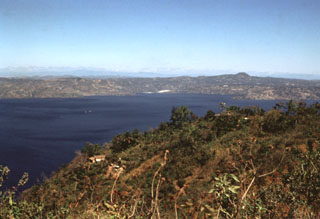 The two tiny islands in the center of Lake Ilopango barely visible above the house in the foreground are the Islas Quemadas. These are post-caldera lava domes that were emplaced from 31 December 1879 to March 1880. A huge ash plume with incandescent ejecta were erupted on 20 January and the dome breached the lake surface on 23 January. It reached a height of 50 m above the lake surface before violent explosions on 5 March destroyed most of the visible part of the dome.
The two tiny islands in the center of Lake Ilopango barely visible above the house in the foreground are the Islas Quemadas. These are post-caldera lava domes that were emplaced from 31 December 1879 to March 1880. A huge ash plume with incandescent ejecta were erupted on 20 January and the dome breached the lake surface on 23 January. It reached a height of 50 m above the lake surface before violent explosions on 5 March destroyed most of the visible part of the dome.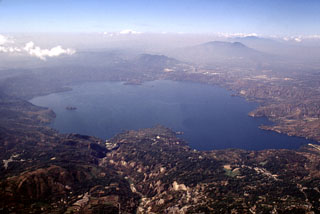 The 8 x 11 km wide Ilopango caldera fills the center of the image in this view from the ESE. Fresh, light-colored exposures of the Tierra Blanca Joven formation in the foreground associated with the latest caldera-forming episode were in part created by landslides during the January 2001 earthquake. The capital city of San Salvador lies beyond the lake, in front of San Salvador volcano (upper right). The Santa Ana volcanic complex lies beyond San Salvador volcano in the background to the far right.
The 8 x 11 km wide Ilopango caldera fills the center of the image in this view from the ESE. Fresh, light-colored exposures of the Tierra Blanca Joven formation in the foreground associated with the latest caldera-forming episode were in part created by landslides during the January 2001 earthquake. The capital city of San Salvador lies beyond the lake, in front of San Salvador volcano (upper right). The Santa Ana volcanic complex lies beyond San Salvador volcano in the background to the far right.There are no samples for Ilopango in the Smithsonian's NMNH Department of Mineral Sciences Rock and Ore collection.
| Copernicus Browser | The Copernicus Browser replaced the Sentinel Hub Playground browser in 2023, to provide access to Earth observation archives from the Copernicus Data Space Ecosystem, the main distribution platform for data from the EU Copernicus missions. |
| MIROVA | Middle InfraRed Observation of Volcanic Activity (MIROVA) is a near real time volcanic hot-spot detection system based on the analysis of MODIS (Moderate Resolution Imaging Spectroradiometer) data. In particular, MIROVA uses the Middle InfraRed Radiation (MIR), measured over target volcanoes, in order to detect, locate and measure the heat radiation sourced from volcanic activity. |
| MODVOLC Thermal Alerts | Using infrared satellite Moderate Resolution Imaging Spectroradiometer (MODIS) data, scientists at the Hawai'i Institute of Geophysics and Planetology, University of Hawai'i, developed an automated system called MODVOLC to map thermal hot-spots in near real time. For each MODIS image, the algorithm automatically scans each 1 km pixel within it to check for high-temperature hot-spots. When one is found the date, time, location, and intensity are recorded. MODIS looks at every square km of the Earth every 48 hours, once during the day and once during the night, and the presence of two MODIS sensors in space allows at least four hot-spot observations every two days. Each day updated global maps are compiled to display the locations of all hot spots detected in the previous 24 hours. There is a drop-down list with volcano names which allow users to 'zoom-in' and examine the distribution of hot-spots at a variety of spatial scales. |
|
WOVOdat
Single Volcano View Temporal Evolution of Unrest Side by Side Volcanoes |
WOVOdat is a database of volcanic unrest; instrumentally and visually recorded changes in seismicity, ground deformation, gas emission, and other parameters from their normal baselines. It is sponsored by the World Organization of Volcano Observatories (WOVO) and presently hosted at the Earth Observatory of Singapore.
GVMID Data on Volcano Monitoring Infrastructure The Global Volcano Monitoring Infrastructure Database GVMID, is aimed at documenting and improving capabilities of volcano monitoring from the ground and space. GVMID should provide a snapshot and baseline view of the techniques and instrumentation that are in place at various volcanoes, which can be use by volcano observatories as reference to setup new monitoring system or improving networks at a specific volcano. These data will allow identification of what monitoring gaps exist, which can be then targeted by remote sensing infrastructure and future instrument deployments. |
| Volcanic Hazard Maps | The IAVCEI Commission on Volcanic Hazards and Risk has a Volcanic Hazard Maps database designed to serve as a resource for hazard mappers (or other interested parties) to explore how common issues in hazard map development have been addressed at different volcanoes, in different countries, for different hazards, and for different intended audiences. In addition to the comprehensive, searchable Volcanic Hazard Maps Database, this website contains information about diversity of volcanic hazard maps, illustrated using examples from the database. This site is for educational purposes related to volcanic hazard maps. Hazard maps found on this website should not be used for emergency purposes. For the most recent, official hazard map for a particular volcano, please seek out the proper institutional authorities on the matter. |
| IRIS seismic stations/networks | Incorporated Research Institutions for Seismology (IRIS) Data Services map showing the location of seismic stations from all available networks (permanent or temporary) within a radius of 0.18° (about 20 km at mid-latitudes) from the given location of Ilopango. Users can customize a variety of filters and options in the left panel. Note that if there are no stations are known the map will default to show the entire world with a "No data matched request" error notice. |
| UNAVCO GPS/GNSS stations | Geodetic Data Services map from UNAVCO showing the location of GPS/GNSS stations from all available networks (permanent or temporary) within a radius of 20 km from the given location of Ilopango. Users can customize the data search based on station or network names, location, and time window. Requires Adobe Flash Player. |
| DECADE Data | The DECADE portal, still in the developmental stage, serves as an example of the proposed interoperability between The Smithsonian Institution's Global Volcanism Program, the Mapping Gas Emissions (MaGa) Database, and the EarthChem Geochemical Portal. The Deep Earth Carbon Degassing (DECADE) initiative seeks to use new and established technologies to determine accurate global fluxes of volcanic CO2 to the atmosphere, but installing CO2 monitoring networks on 20 of the world's 150 most actively degassing volcanoes. The group uses related laboratory-based studies (direct gas sampling and analysis, melt inclusions) to provide new data for direct degassing of deep earth carbon to the atmosphere. |
| Large Eruptions of Ilopango | Information about large Quaternary eruptions (VEI >= 4) is cataloged in the Large Magnitude Explosive Volcanic Eruptions (LaMEVE) database of the Volcano Global Risk Identification and Analysis Project (VOGRIPA). |
| EarthChem | EarthChem develops and maintains databases, software, and services that support the preservation, discovery, access and analysis of geochemical data, and facilitate their integration with the broad array of other available earth science parameters. EarthChem is operated by a joint team of disciplinary scientists, data scientists, data managers and information technology developers who are part of the NSF-funded data facility Integrated Earth Data Applications (IEDA). IEDA is a collaborative effort of EarthChem and the Marine Geoscience Data System (MGDS). |